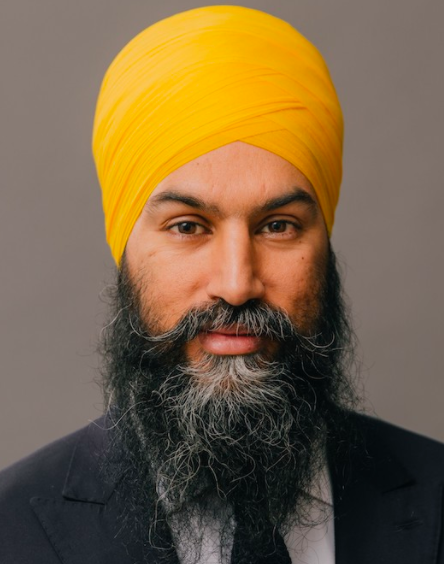An analysis of The Tyee’s social media use and the globalization of news values and ethics.
The Tyee is useful as a case study to examine the uses of social media. Founded in 2003, The Tyee is self-described as an independent, online news magazine that utilizes fact-driven reporting to enliven the democratic conversation.
The nature of The Tyee being a digital-only outlet that began near the precipice of the internet and social media means that they have had to consistently stay afloat with changing social platforms. Using a piece that interviews NDP leader Jagmeet Singh, there are subtle similarities and differences with how The Tyee uses social media to attract readership.
Twitter is a platform that makes it easy to follow news in realtime. Users can choose any number of outlets to follow and get updates on a streaming timeline. There is a quick speed to Twitter that is beneficial, yet stories and news can get lost as the timeline streams onward. For that reason, The Tyee posted multiple posts to find new readers.
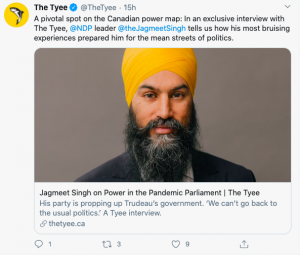
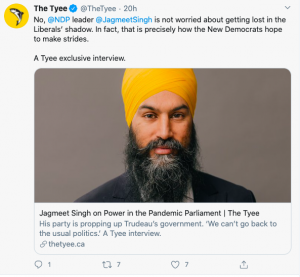
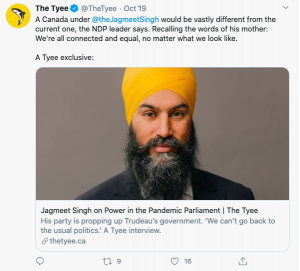
Images captured via Twitter on Oct. 20, 2020
In a little over 24 hours, the article was posted three times to garner readership. As the article aged, the social media interaction waned, from nine to seven to three retweets and 16 to seven to nine likes. Notably, The Tyee has just over 61,000 followers on Twitter, so this is seemingly a fairly poor showing for a post.
However, Twitter does keep track of “impressions” and “engagements,” which can only be seen by the user of the Twitter account. In this instance, The Tyee may be having a lot more engagement than perceived from the outside. Moreover, increasing the number of posts gives more chances for Twitter users across timezones to engage with content.
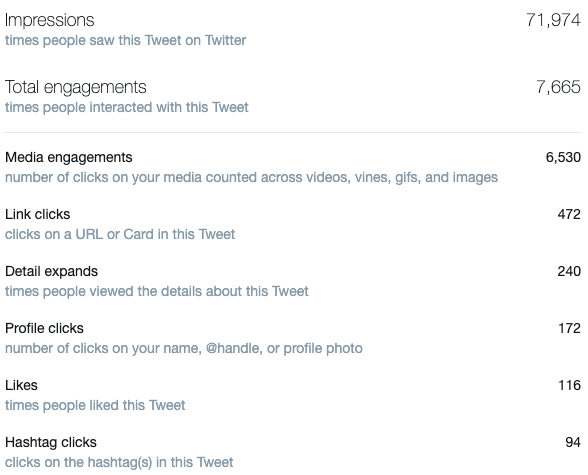
An example of the information Twitter has about a post beyond the likes and retweets. This post of mine reached nearly 72,000 people yet I had less than 50 followers at the time.
The Tyee additionally didn’t regurgitate the same post all three times. They had overlapping keywords: “exclusive,” “NDP” and “Jagmeet Singh.” Both NDP and Jagmeet Singh were also tagged in all but one post. The other information was used to humanize Singh: a short excerpt including his mother, a “bruising” history and being unfettered by the liberal government. Ultimately, this is meant to entice new readership with each post.
There were very subtle differences between The Tyee’s use of Twitter and Facebook. The most pronounced was that The Tyee only made one Facebook post about this article, which seemed like a pattern for its Facebook page. Stylistically, The Tyee created a Facebook “page” rather than a “friend” while with Twitter there is not a clear distinction between outlets and people.
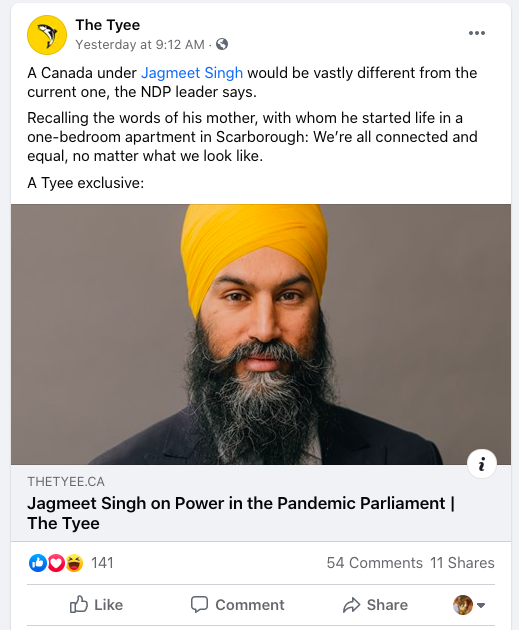
Image captured via Facebook on Oct. 20, 2020
The Tyee’s Facebook page has about 23,000 likes and 25,000 followers, just about a third compared to Twitter. Notably, this post had increased interaction.
Like Twitter, Facebook can also give data about unperceived engagement. The Facebook post is similar to the initial Twitter post but it is more sympathetic by noting he and his mother’s shared housing. It ends as the Twitter post does, imploring equality despite physical differences.
No emojis are used in this post nor most of the posts on either platform. With a quick scan, however, Facebook’s emoji reaction “Haha” highlights a few contrarians.
The Tyee certainly uses both Facebook and Twitter similarly, yet because of subtle differences such as being labeled “page” versus “friend” or “follower,” they uniquely utilize each platform to garner new readership and engagement.
Globalizing news values and ethics
Although there are some distinctions between traditional news and new media news values, social media has not changed many news values or ethics overall. In fact, social media has given journalists a tool to globalize news values, which, ethically, has to be carefully managed.
Essentially, social media globalizes traditional news values. For instance, timeliness and proximity are considered news values. Social media can make any story feel timely and close with its reach. In the past, conflict in a foreign country felt far, yet nowadays you can watch it unfold by clicking a hashtag. Similarly, social media is highlighted by its never-ending frequency. Just like 24-hour television news channels, social media is always ongoing.
Since social media promotes both outlets and journalists — thereby promoting personal opinions — there is leeway for journalists to act as agents of change, which betrays traditional objectivity. This reflects Miljan and Cooper’s (2003) argument that they expected journalists to promote social change despite objectivity (p. 59). Yet Callison and Young (2020) explain that traditional objectivity is rooted in white masculinity (p. 5). Thus, objectivity was never actually objective. It is therefore difficult to betray a value that was never a reality.
Ethically, journalists are charged to act independently and report the truth. Social media allows this: They can say what they want but journalists can also more easily make public mistakes or have consequences for their online actions. Regarding the responsibility to minimize harm, this power can be abused as outlets and journalists alike can sensationalize stories and testimonies to reflect personal or political agendas.
Yet, prior to social media, the press had power and that power was sometimes misused or abused. While social media changed the power structure as it gives journalists more personal freedom, it has not actually changed any ethics.
Still, the ethical considerations of late are like cracks in the sidewalk: They are navigable but need to be taken one step at a time. Before social media, journalists had their work go through editors. Now, reaching the public is at their fingertips. Much like before, journalists have to shoulder this ethical responsibility but, nowadays, they must rely on themselves to make sound judgments.
***
References
Callison, C., & Mary Lynn Young. (2020). Reckoning: journalism’s limits and possibilities. Oxford University Press.
Carlson, T. [@TuckerCarlson]. (2020, October 15). The show has obtained new Hunter Biden emails that expose corruption. You will not want to miss tonight’s report [Tweet]. Twitter. https://twitter.com/TuckerCarlson/status/1316850501586219013
ESPN suspends anchor Jemele Hill for 2 weeks. (2017, October 9). ESPN.Com. https://www.espn.com/espn/story/_/id/20971317/espn-anchor-jemele-hill-suspended-2-weeks-second-violation-social-media-rules
Harris, M. (2020, October 19). Jagmeet Singh on Power in the Pandemic Parliament. The Tyee. https://thetyee.ca/News/2020/10/19/Jagmeet-Singh-Power-Pandemic-Parliament/
Leiter, R. (2005, May 15). “Buried by The Times”: Horror Story (Published 2005). The New York Times. https://www.nytimes.com/2005/05/15/books/review/buried-by-the-times-horror-story.html
Miljan, L. A., & Cooper, B. (2003). Hidden agendas : how journalists influence the news. Ubc Press.
Stelter, B. (2015, June 3). BBC journalist faces internal investigation after false tweet about queen. CNNMoney. https://money.cnn.com/2015/06/03/media/queen-tweet-mistake-bbc/
The Tyee [@TheTyee]. (n.d.). Tweets [Twitter profile]. Retrieved October 20, 2020 from https://twitter.com/TheTyee
The Tyee (n.d.). Home [Facebook page]. Facebook. Retrieved October 20, 2020 from https://www.facebook.com/TheTyee/
What is The Tyee? (n.d.). The Tyee. Retrieved October 20, 2020 from https://thetyee.ca/About/Us/
